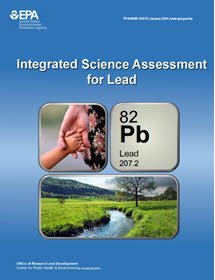Integrated Science Assessment (ISA) for Lead
[Notice] EPA announced the availability of the Integrated Science Assessment (ISA) for Lead (Final Report) (EPA/600/R-23/375). [Federal Register Notice February 7, 2024]
On this page:
The Issue
Lead (Pb) emitted into air can be inhaled or ingested or can deposit and accumulate in other environmental media (e.g., soil, water, sediment, biota), contributing to a wide range of effects in humans and wildlife. Pb affects nearly every organ system in humans, including nervous system effects in children and adults; cardiovascular effects; renal effects; hematological effects; and effects on development and reproductive function. Effects of Pb in ecosystems are primarily associated with Pb from deposition and other sources, and subsequent transport in environmental media (soil, sediment, water), where biota can be exposed to this metal. Pb bioaccumulates in plants and animals, and may lead to affects in terrestrial, freshwater, and saltwater organisms.
EPA Action
Since the 1980's, EPA and its federal partners have phased out Pb in gasoline, reduced Pb in drinking water and industrial air pollution, and banned or limited Pb used in consumer products such as residential paint. As a result of these regulatory efforts, levels of Pb in the air have decreased by about 88% between 1990 and 2021. Concentration trends of Pb in soil, sediments and organisms far from point sources are decreasing over time consistent with the elimination of leaded gasoline and industrial releases nationally and globally. Blood Pb levels have also decreased dramatically among U.S. children and adults over the past forty-five years. As estimated from the National Health and Nutrition Examination Survey, geometric mean blood Pb levels in children aged 1-5 years dropped from 15.2 (95% CI: 14.3, 16.1)μg/dL in 1976-1980 (99.8% exceeding 5 µg/dL) to 0.8 (95% CI: 0.8, 0.9) μg/dL in 2011-2016 (1.3% exceeding 5 µg/dL).
The Clean Air Act requires EPA to periodically review the science for six major air pollutants, including Pb. EPA's Center for Public Health and Environmental Assessment (CPHEA) develops ISAs that summarize and evaluate the science related to the human health and welfare effects caused by these pollutants. ISAs provide a comprehensive evaluation and synthesis of the policy-relevant scientific literature published since the last National Ambient Air Quality (NAAQS) review and serve as the scientific foundation for establishing and reviewing the primary (health-based) and secondary (welfare-based) NAAQS. EPA released the Integrated Science Assessment for Lead Final Report in January 2024.
- Learn about the Integrated Science Assessments for Lead (2024)
History
| Date | Milestone |
|---|---|
| Jan 2024 | EPA released the document Integrated Science Assessment for Lead (Final, 2024) (EPA/600/R-23/375). This is the most recent Pb ISA. [Federal Register Notice February 7, 2024] |
|
Jun 2013 |
EPA released the document Integrated Science Assessment for Lead (Final, 2013) (EPA/600/R-10/075F). [Federal Register June 26, 2013] |
| Oct 2006 | EPA released the document Air Quality Criteria for Lead (Final, 2006) (EPA/600/R-05/144). [Federal Register Sep 29, 2006] |
| Aug 1990 | EPA released the document Air Quality Criteria for Lead: Supplement to the 1986 Addendum (EPA/600/8-89/049F). |
| Jun 1986 | EPA released the document Air Quality Criteria for Lead (Final, 1986) (EPA/600/8-83/028A-F). |
| Dec 1977 | EPA released the document Air Quality Criteria for Lead (Final, 1977) (EPA-600/8-77/017). |
Peer Review Literature
Explore the literature cited in the 2024 Pb ISA in the Health and Environmental Research Online, HERO, database project page.
HERO is a searchable database of more than 1.6 million scientific studies and other references used to develop EPA assessments for understanding the health and environmental effects of pollutants and chemicals.
Get the Report

(155 pp, 4 MB, About PDF)
